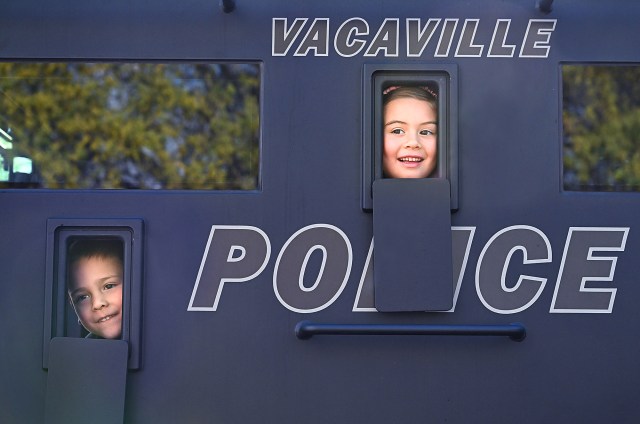They heard it before they saw it. The excitement of anticipation animated the Orchard Elementary students seated on the asphalt playground Thursday at the North Orchard Avenue campus.
Then they saw it, looking like a giant white grasshopper, traveling and circling swiftly one hundred yards above them on a clear, sunny morning – a California Highway Patrol helicopter getting ready to land in an open, grassy area at the K-6 Vacaville school.
Gradually the wop, wop, wop sound grew louder as the helicopter began to descend, while more than 200 students looked skyward – some with their arms raised – and shrieked enough to drown out the helicopter rotors’ pulsing rhythms. Once on the ground, the helicopter’s surface winds buffeted everything nearby, like a gale, but faded quickly.
The arrival of the helicopter – piloted by CHP officer Ken Tyler – clearly capped the school’s First Responder Day. It was a day of seeing and learning about police vehicles, fire engines, ambulances, and the helicopter as they asked questions of firefighters, police and CHP officers.
Second-grade student Alex Vasquez, 8, said he watched “quietly” as the copter landed but was excited to see it.
His triplet sister and classmate, Austyn, who wants to be a nurse when she grows up, said of the copter landing, “I thought it was cool. It got to be at our school.”
Asked what she thought of first responders, she said, “They help people.”
A few moments later, as two classes clustered next to the copter, the students heard CHP flight officer/paramedic Dallas Whedbee explain a few things about the multimillion-dollar aircraft.
Among the questions were how fast does it travel? Answer: 135 knots, maximum speed.
What kind of missions does it fly? Answer: rescue, search-and-rescue, and law enforcement.
How high does it fly? Answer: 23,000 feet.
Tyler said he and his team are usually especially busy during the spring, summer and fall, but not so much during winter months. If necessary, they and the helicopter can respond to calls received anywhere among the nine Bay Area counties.
Fielding questions one by one, Whedbee explained that a surveillance camera mounted on the underside of the helicopter costs $1 million.
How long is the helicopters’ rescue cable? It can stretch to the length of a 16-story building, or about 165 feet, he said.
The diameter of the rotor span when fully spread? 35 feet.
Members of the Vacaville Police Departments’ motorcycle unit and their gleaming, black-and-white BMWs were on hand, too.
Officers Adrian Delos Santos, Sieren Smith and Matt Bowen said elementary school students typically ask, “How fast do you go?” Teachers, said Bowen, “Ask about driving safely.”

Parked across the asphalt playground were a bus-like Vacaville Police mobile command vehicle and the armored Bearcat and Bear vehicles, the former a rescue vehicle used by the department’s SWAT team.
Standing alongside the Bearcat, Sgt. Mike Brennan, who operates drones, said students often ask him, “What is the favorite part of your job?” and he replied, “I get to help people.”
Earlier in the morning Vacaville firefighter/paramedic Tony Fray held an informal tutorial while standing next to fire engine EM71.
As he opened the vehicle’s side panel, he pointed to satchels containing emergency medical gear, including a device, he told students in Lauren Soest’s third-grade class, that “monitors someone’s heart rhythms.”
The engine also is outfitted with foam-dispensing equipment used emergency responses.
“It’s kind of like bubble bath,” said Fray.
Soest, moving her students from one display station to the next, called First Responder Day “one of our favorite events every year.”
